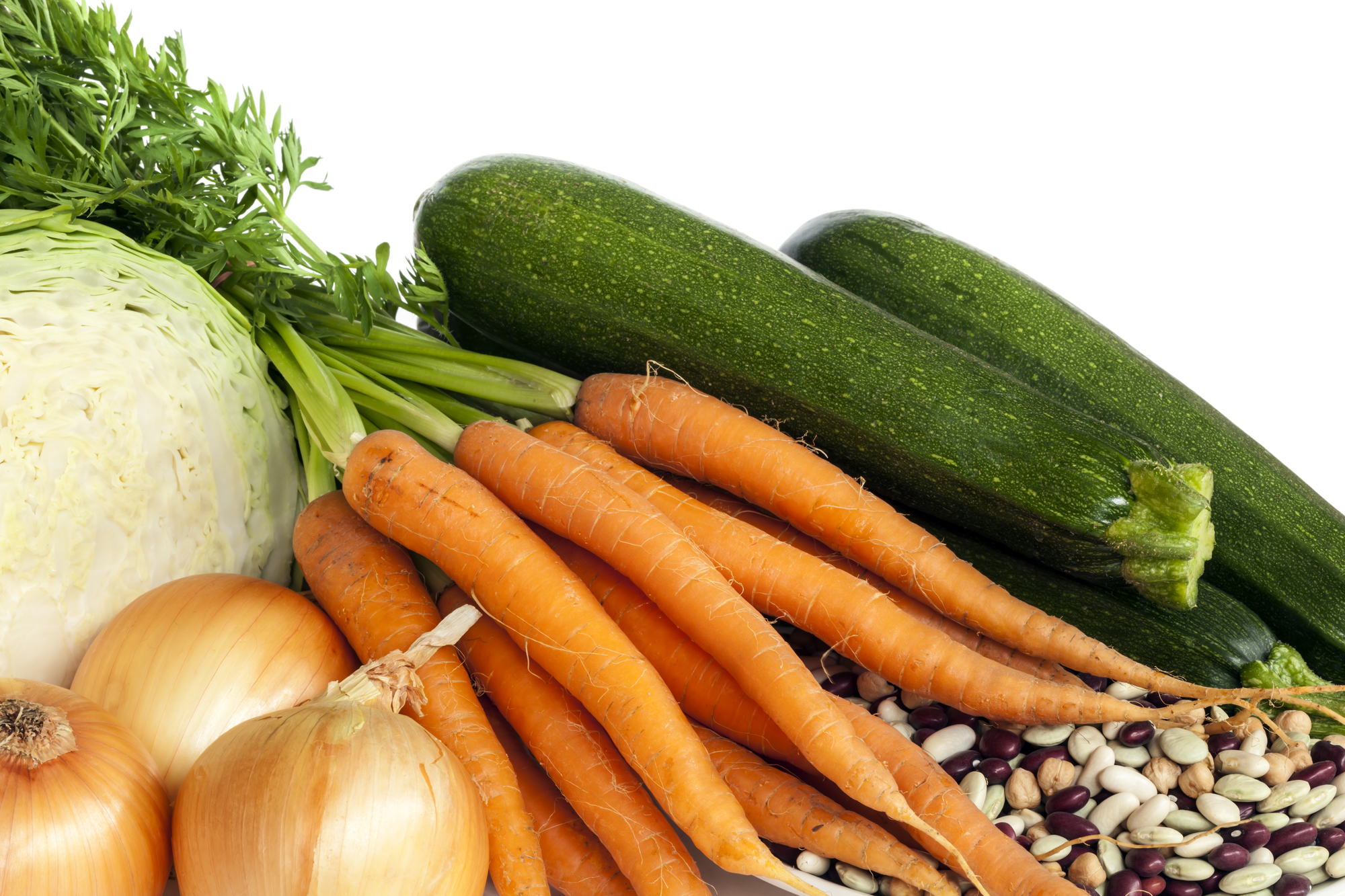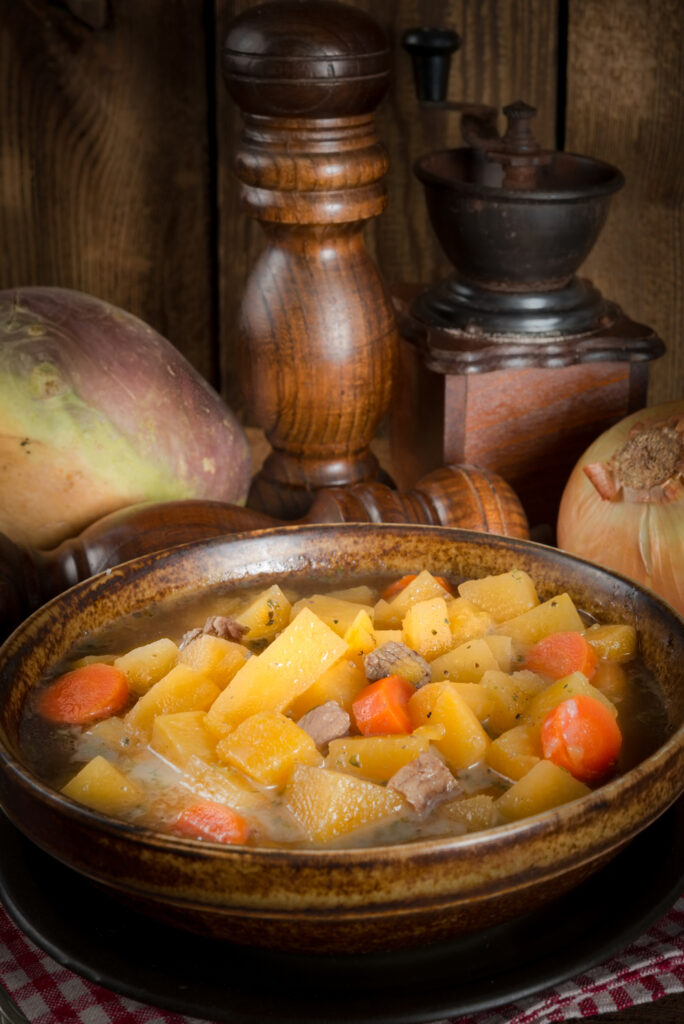
Soups for Four Seasons
In the days before electrical refrigeration, soups were usually made with vegetables that were in season. Preparing and cooking soup took many hours. These four seasonal soups have meat as a base for flavoring, but the meat is never left in the soup to be eaten. Because of the long, slow cooking, all of the flavor is extracted and the meat discarded.
INFORMATION BELOW FROM 1800s COOKBOOKS
SPRING SOUP
Unless your dinner hour is very late, the stock for this soup should be made the day before it is wanted, and set away in a stone pan, closely covered. To make the stock, take a knuckle of veal, break the bones, and cut it into several pieces. Allow a quart of water to each pound of veal. Put it into a soup-pot, with a set of calves’ feet, and some bits of cold ham cut off near the hock. If you have no ham, sprinkle in a teaspoon of salt, and a saltspoon* of cayenne. Place the pot over a moderate fire, and let it simmer slowly (skimming it well) for several hours, till the veal is all in rags and the flesh of the calves’ feet has dropped in shreds from the bones. Then strain the soup and if not wanted that day, set it away in a stone pan, as above mentioned.
Next day, have already boiled two quarts or more of green peas, (they must on no account be old) and a pint of the green tops cut off from asparagus boiled for the purpose. In boiling the peas for this soup, you may put with them half a dozen sprigs of green mint to be afterwards taken out.
Pound a handful of raw spinach till you have extracted a teacup* of the juice. Set the soup or stock over the fire, add the peas, asparagus, and spinach juice, stirring them well. Also add one-fourth pound of fresh butter divided into four bits and rolled in flour. Let the whole come to a boil, and then take it off and transfer it to a tureen. It will be found excellent.
*saltspoon – a miniature spoon used with an open salt cellar for individual use before table salt was free-flowing.
*teacup – same as a jill or gill (four ounces U.S.)
SUMMER SOUP
Take a large neck of mutton and hack it so as nearly to cut it apart, but not quite. Allow a quart of water to each pound of meat and sprinkle on a teaspoon of salt and a very little black pepper. Put it into a soup-pot and boil it slowly (skimming it well) till the meat is reduced to rags. Then strain the liquid, return it to the soup-pot, and carefully remove all the fat from the surface.
Have ready half a dozen small turnips sliced thin, two young onions sliced, a tablespoon of sweet marjoram leaves picked from the stalks, and a quart of shelled Lima beans. Put in the vegetables and boil them in the soup till they are thoroughly done. You may add to them two tablespoons of green nasturtium seeds, either fresh or pickled. Put in also some little dumplings, (made of flour and butter) about ten minutes before the soup is done.
Instead of Lima beans, you may divide a cauliflower or two broccolis into sprigs, and boil them in the soup with the other vegetables.
This soup may also be made of a shoulder of mutton, cut into pieces and the bones cracked.
AUTUMN SOUP
Begin this soup as early in the day as possible. Take six pounds of the lean of fine fresh beef cut it into small pieces. Sprinkle it with a teaspoon of salt, put it into a soup-pot, and pour on six quarts of water. The hock of a cold ham will greatly improve it. Set it over a moderate fire and let it boil slowly. After it comes to a boil, skim it well. Have ready one-fourth peck* of okras cut into very thin round slices, one-fourth peck of tomatoes cut into pieces, and a quart of shelled Lima beans. Season them with pepper. Put them in and after the whole has boiled three hours at least, take four ears of young Indian corn,* and having grated off all the grains, add them to the soup and boil it an hour longer. Before you serve up the soup, remove from it all the bits of meat, which, if the soup is sufficiently cooked, will be reduced to shreds.
You may put in with the okras and tomatoes one or two sliced onions. The soup, when done, should be as thick as a jelly.
Okras for soup may be kept all winter by tying them separately to a line stretched high across the storeroom.
*peck – measurement for dry volume; a peck is two gallons or eight dry quarts. Four pecks make a bushel.
*Indian corn – the maize plant.

WINTER SOUP
The day before you make the soup, get a leg or shin of beef. Have the bone sawed through in several places, and the meat notched or scored down to the bone. This will cause the juice or essence to come out more freely when cooked. Rub it slightly with salt, cover it, and set it away. Next morning, as soon as the fire is well made up, put the beef into a large soup-pot, allowing to each pound a quart of water. Then taste the water, and if the salt that has been rubbed on the meat is not sufficient, add a very little more. Throw in also a teaspoon of whole peppercorns, and you may add half a dozen blades of mace. Let it simmer slowly till it comes to a boil; then skim it well. After it boils, you may quicken* the fire. At nine o’clock, put in a large head of cabbage cut fine as for cold-slaw, six carrots grated, the leaves stripped from a bunch of sweet marjoram, and the leaves of a sprig of parsley.
An hour afterwards, add six turnips and three potatoes, all cut into four or eight pieces. Also two onions, which will be better if previously roasted brown, and then sliced. Keep the soup boiling steadily, but not hard, unless the dinner hour is very early. For a late dinner, there will be time to boil it slowly all the while, and all soups are the better for long and slow boiling. See that it is well skimmed, so that, when done, there will be not a particle of fat or scum on the surface. At dinner-time take it up with a large ladle, and transfer it to a tureen. In doing so, carefully avoid the shreds of meat and bone. Leave them all in the bottom of the pot, pressing them down with the ladle. A mass of shreds in the tureen or soup-plate looks slovenly and disgusting, and should never be seen at the table. Also, they absorb too much of the liquid.
In very cold weather, what is left of this soup will keep till the second day, when it must be simmered again over the fire, till it just comes to a boil. Put the soup away in a tin or stone vessel. The lead which is used in glazing earthen jars frequently communicates its poison to liquids that are kept in them.
*quicken – add fuel; make a fire hotter.
Photo from Deposit Photos
=================================================
Wouldn’t cooks in the 1800s be amazed at being able to use slow cookers and Instant Pots
to make soup? What a time saver!
Instant Pot 6 Qt 7-in-1 Multi-Use Programmable Pressure Cooker, Slow Cooker, Rice Cooker, Steamer, Sauté, Yogurt Maker and Warmer
=================================================
Do you like soups throughout the year? Please leave a comment below.
=================================================




3 thoughts on “Soups for Four Seasons”
We love soup at our house. Love our Instant Pot, too. We buy local meat and if you ask they will include soup bones. Bone broth is so good and so easy to make in the Instant Pot. These recipes sound delicious!
I guess calves feet and a knuckle of mutton are hard to find in a butchers these days, but the soups sound really good. I guess it was a way of using just about every part of the animal. Me? I’m a real soup lover, so good and warming on a cold day.
I can never find any meat in grocery stores with the bones still in them or with a layer of fat. All the meat is sold as “lean.” Fat and bones are what gives meat flavor. I need to find a regular butchers shop and buy my meat there.